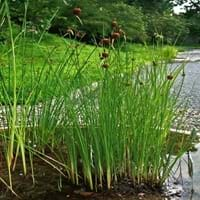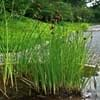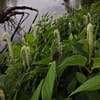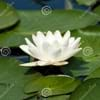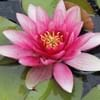Life Span
Perennial
Perennial
Origin
Eastern Europe, Western Asia
Asia, Europe
Types
Common Cattail, Southern Cattail, Dwarf Bulrush
Elfin Thyme, Pink Chintz Thyme, Lime Thyme, White Moss Thyme, Lavender Thyme, Silver Needle Thyme
Number of Varieties
Not Available
Habitat
Lake margins, Ponds, Swamps
Rocky areas
USDA Hardiness Zone
3-11
6-9
Sunset Zone
21,22
1a, 1b, 2a, 2b, 3a, 3b, 4, 5, 6, 7, 8, 9, 10, 11, 12, 13, 14, 15, 16, 17, 18, 19, 20, 21, 22, 23, 24
Habit
Upright/Erect
Cushion/Mound-forming
Minimum Width
Not Available
Flower Color
Yellow, Green, Brown, Chocolate
Crimson, Lavender, Pink, White
Flower Color Modifier
Not Available
Unknown
Fruit Color
Light brown, Light Red
Not Available
Leaf Color in Spring
Green, Dark Green
Green
Leaf Color in Summer
Green, Dark Green
Gray Green
Leaf Color in Fall
Green, Dark Green
Gray Green
Leaf Color in Winter
Brown
Gray Green
Leaf Shape
Long linear and narrow
Tiny
Plant Season
Summer, Fall, Winter
Summer
Sunlight
Full Sun, Partial Sun
Full Sun, Part sun
Type of Soil
Clay, Loam, Sand
Loamy, Sandy
The pH of Soil
Acidic, Neutral
Neutral, Slightly Alkaline
Soil Drainage
Poorly Drained
Well drained
Bloom Time
Summer, Late Summer, Early Fall
Fall, Spring, Summer, Winter
Tolerances
Wet Site
Drought
Where to Plant?
Container, In Water
Container, Ground
How to Plant?
Runners
Seedlings, Stem Planting
Plant Maintenance
Low
Medium
Watering Requirements
Plant grows in water
Do not water frequently, Does not require lot of watering, Requires watering in the growing season, Water occasionally
In Summer
Aquatic Plant
Lots of watering
In Spring
Aquatic Plant
Moderate
In Winter
Aquatic Plant
Average Water
Soil pH
Acidic, Neutral
Neutral, Slightly Alkaline
Soil Type
Clay, Loam, Sand
Loamy, Sandy
Soil Drainage Capacity
Poorly Drained
Well drained
Sun Exposure
Full Sun, Partial Sun
Full Sun, Part sun
Pruning
Prune in early spring, Remove damaged leaves, Remove dead branches, Remove dead leaves
Prune for shortening long shoots, Prune if you want to improve plant shape, Prune lower leaves, Requires extensive pruning
Fertilizers
Nitrogen, Phosphate
All-Purpose Liquid Fertilizer
Pests and Diseases
Red blotch
Alternaria leaf blight, Aphids, Botrytis collar rot, Rhizoctonia Root Rot, Spider mites
Plant Tolerance
Drought
Drought
Flower Petal Number
Single
Not Available
Fragrant Bark/Stem
No
Yes
Foliage Texture
Medium
Fine
Foliage Sheen
Matte
Matte
Attracts
Birds, Flying insects
Butterflies
Allergy
Not Available
Diarrhea, Skin irritation
Aesthetic Uses
Beautification, Showy Purposes, Water gardening
Beautification, Showy Purposes, Used for decorating walls, fences, gates, hedges, etc.
Beauty Benefits
Not Available
Not Available
Environmental Uses
Food for animals, Food for birds, Food for insects, Nesting sites for birds
Air purification
Medicinal Uses
Nutrients
Arthritis, Bronchitis, Chronic fatigue, Cough, Gastritis, Hair Loss, Insomnia, Kidney problems, Muscle Pain, Skin irritation, Snoring, Sore throat, Stomach pain, Swelling
Part of Plant Used
Leaves
Whole plant
Other Uses
Decoration Purposes, Showy Purposes, Used as Ornamental plant
Air freshner, Cosmetics, Economic Purpose, Employed in herbal medicine, Oil is used in perfume, soaps, creams, etc., Showy Purposes, Used As Food, Used as Ornamental plant, Used for fragrance
Used As Indoor Plant
Yes
Yes
Used As Outdoor Plant
Yes
Yes
Garden Design
Bog Garden, Container, Water Gardens
Container, Edible, Herb, Rock Garden
Botanical Name
TYPHA minima
Thymus vulgaris
Common Name
Dwarf Cattail
Thyme
In Hindi
बौना कैटेल
अजवायन के फूल
In German
Dwarf Rohrkolben
Thymian
In French
Cattail nain
Thym
In Spanish
Espadaña enano
Tomillo
In Greek
Νάνος Cattail
θυμάρι
In Portuguese
Tifa Dwarf
Tomilho
In Polish
Dwarf Ożypałka
Tymianek
In Latin
Pumilio Cattail
Thymum
Phylum
Tracheophyta
Magnoliophyta
Class
Liliopsida
Magnoliopsida
Order
Poales
Not Available
Family
Typhaceae
Labiatae
Clade
Angiosperms, Commelinids, Monocots
Not Available
Tribe
Not Available
Not Available
Subfamily
Not Available
Not Available
Number of Species
Not Available
Importance of Dwarf Cattail and Thyme
Want to have the most appropriate plant for your garden? You might want to know the importance of Dwarf Cattail and Thyme. Basically, these two plants vary in many aspects. Compare Dwarf Cattail and Thyme as they differ in many characteristics such as their life, care, benefits, facts, etc. Every gardener must at least have the slightest clue about the plants he wants to plant in his garden. Compare their benefits, which differ in many ways like facts and uses. The medicinal use of Dwarf Cattail is Nutrients whereas of Thyme is Arthritis, Bronchitis, Chronic fatigue, Cough, Gastritis, Hair Loss, Insomnia, Kidney problems, Muscle Pain, Skin irritation, Snoring, Sore throat, Stomach pain and Swelling. Dwarf Cattail has beauty benefits as follows: Not Available while Thyme has beauty benefits as follows: Not Available.
Compare Facts of Dwarf Cattail vs Thyme
How to choose the best garden plant for your garden depending upon its facts? Here garden plant comparison will help you to solve this query. Compare the facts of Dwarf Cattail vs Thyme and know which one to choose. As garden plants have benefits and other uses, allergy is also a major drawback of plants for some people. Allergic reactions of Dwarf Cattail are Not Available whereas of Thyme have Diarrhea and Skin irritation respectively. Having a fruit bearing plant in your garden can be a plus point of your garden. Dwarf Cattail has no showy fruits and Thyme has no showy fruits. Also Dwarf Cattail is not flowering and Thyme is flowering. You can compare Dwarf Cattail and Thyme facts and facts of other plants too.
